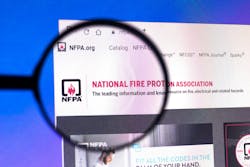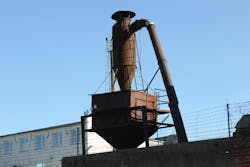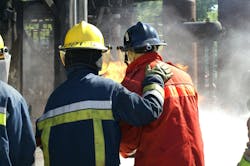NFPA 660: What every facility needs to know about the new combustible dust standard
Key takeaways:
- NFPA 660 combines all previously existing combustible dust standards into a single document.
- NFPA 660 strengthens DHA requirements, eliminates "grandfathering" of older plants, provides more specific guidance on equipment and housekeeping, and includes new emergency preparedness requirements.
- NFPA 660 is widely considered the best available guidance on combustible dusts, is enforceable when adopted by local authorities, and may be required by insurers and corporate risk auditors as a condition for coverage or contract approval.
Combustible dust might not always look dangerous, but under the right conditions it can cause devastating fires or explosions. Over the past two decades, major incidents including the 2008 Imperial Sugar plant explosion and the 2017 Didion Milling blast have shown how fine particles, when suspended in air, can become destructive with little warning.
To help prevent future tragedies, the National Fire Protection Association (NFPA) released a new standard in December 2024: NFPA 660 – Standard for Combustible Dusts and Particulate Solids. This new standard brings together many older dust safety standards into one, unified framework — and it is something every facility handling powders or fine materials needs to understand.
Why NFPA 660 matters now
Before NFPA 660, dust safety rules were spread across multiple NFPA documents. Different industries, such as food, metalworking, woodworking, and chemical manufacturing, had their own separate standards. While those were helpful, they could also be confusing, especially for facilities that worked with more than one type of material.
NFPA 660 clears up the confusion by combining all previously effective combustible dust standards into a single, easier-to-follow document. Instead of juggling multiple sets of rules, facility teams now have one clear guide — whether they handle grain, aluminum powder, wood dust, sulfur, or other types of particulate solids.
This consolidation improves safety by reducing conflicting interpretations, ensuring more consistent audits, and making it easier for facilities to demonstrate compliance.
What NFPA 660 replaces
The following NFPA standards are now covered within NFPA 660:
- NFPA 61 – Agricultural and food processing
- NFPA 484 – Combustible metals
- NFPA 652 – Fundamentals of combustible dust
- NFPA 654 – General industry particulate solids
- NFPA 655 – Sulfur fires and explosions
- NFPA 664 – Wood processing and woodworking
Each of these legacy standards still plays a role within NFPA 660, but they are now part of a unified document with shared terminology, consistent safety expectations, and cross-industry applicability.
For companies that span multiple sectors — or operate with integrated materials (e.g., mixing combustible food additives with metal catalysts) — this simplification reduces confusion and saves time.
How NFPA 660 is structured
NFPA 660 is organized in a logical, easy-to-navigate way:
- Chapters 1–10 cover the core principles of combustible dust safety that apply to all industries. Topics include dust characteristics, hazard analysis, equipment design, and emergency response.
- Chapters 21–25 address industry-specific practices for food, metals, wood, sulfur, and other general solids.
- Annexes A–Z provide helpful reference material including sample Dust Hazard Analyses (DHAs), property testing guidelines, and explanations of technical terms.
By separating general and industry-specific content, NFPA 660 makes it easier for facilities to locate the information that applies to them — without missing critical foundational requirements.
What is new in NFPA 660?
While much of the technical foundation remains, NFPA 660 introduces several important updates and clarifications.
Stronger DHA requirements. All facilities handling combustible dust must perform a DHA. NFPA 660 clarifies:
- The DHA must be conducted or led by a qualified facilitator, with expertise in combustible dust hazards.
- The team should include operations, maintenance, engineering, and safety representatives to ensure practical input.
- Facilities must test or validate dust properties such as:
- Kst (explosiveness)
- Pmax (maximum pressure)
- MEC (minimum explosible concentration)
- MIE (minimum ignition energy)
- MIT-layer (minimum ignition temperature for surface layers)
It is no longer acceptable to rely only on vendor data or general reference values for dust properties — especially when material conditions may change during handling, processing, or storage.
No more “grandfathering” of older systems. One of the biggest shifts in NFPA 660 is the removal of age-based exemptions. Previously, older equipment or facilities might have been considered compliant if built before a certain date. Now, all systems — regardless of installation age — must meet current safety expectations.
This includes:
- Ensuring that explosion protection is properly installed and sized
- Reassessing relief venting and isolation valves
- Verifying the effectiveness of dust collection and housekeeping systems
If your equipment is still functional but does not meet today’s standards, it will likely need to be retrofitted, modified, or evaluated for removal.
More specific guidance on equipment and housekeeping. NFPA 660 includes expanded requirements for high-risk equipment and areas where dust commonly accumulates:
- Explosion panels are required on the outer legs of bucket elevators in many cases.
- Ingredient or material transfer systems must meet new design criteria to qualify for explosion protection exemptions.
- Portable vacuum systems must meet certification standards (e.g., UL or CSA) and be rated for combustible dust collection.
- Compressed air blow-down cleaning must be controlled to avoid suspending hazardous dust into the air.
- Housekeeping programs must now be evaluated during the DHA, not treated as a separate concern.
These changes reflect known failure points in past incidents and provide clearer expectations for how to prevent them.
Emergency response planning is now required. NFPA 660 includes a new chapter (Chapter 10) on emergency preparedness, formalizing expectations that were previously left to interpretation:
- Facilities must develop site-specific emergency response plans for dust-related fires, flash fires, or explosions.
- These plans must include safe shutdown procedures, isolation strategies, and coordination with local emergency services.
- Training and drills should be conducted regularly to ensure workers know how to respond in high-risk scenarios.
This formalization reflects a broader understanding that prevention is critical — but so is preparedness.
How to complete (and maintain) a DHA
Performing a DHA is not just about checking a box — it is about understanding where and how dust hazards might appear and what controls are in place to prevent escalation. To do a DHA right:
- Map out all dust-generating and dust-handling processes using updated flow diagrams and P&IDs.
- Identify areas of accumulation, suspension, and ignition potential, such as silos, conveyors, filters, and dryers.
- Test dust samples that reflect real-world conditions (not just bulk raw materials).
- Evaluate existing controls, including isolation valves, vent panels, inerting systems, and suppression units.
- Document findings, assign risk levels, and create a corrective action plan.
Revalidation is required at least every five years, or sooner if you’ve made any changes to your materials, processes, or facility layout.
Why bringing in a DHA expert makes a difference
While NFPA 660 outlines what a DHA must include, getting it right often depends on who is leading the process.
Facilities benefit greatly from working with a DHA expert — someone who not only understands the technical requirements but also knows how to identify subtle risks and offer practical, facility-specific solutions. This is especially valuable when dealing with legacy equipment, changing raw materials, or complex process lines.
An experienced facilitator helps streamline the DHA process and makes the DHA more actionable. Key advantages include:
- Uncovering overlooked hazards or system vulnerabilities
- Recommending mitigation strategies that align with existing operations
- Ensuring that test data reflects actual plant conditions
- Preparing teams for revalidation or external audits
With expert support, facilities can go beyond basic compliance and build a safety program that is proactive, effective, and future-ready.
Is NFPA 660 enforceable?
NFPA 660 is enforceable — when it is adopted by the local authority having jurisdiction (AHJ). In many areas, local fire marshals, building departments, or state code officials reference NFPA standards through the International Fire Code (IFC) or similar frameworks. Even if NFPA 660 is not yet law in your region, it is widely considered the best available guidance and may be used as a benchmark by OSHA under the General Duty Clause. Additionally, many insurers and corporate risk auditors are aligning with NFPA 660 as a condition for coverage or contract approval.
What companies should do next
NFPA 660 is not about reinventing your safety system, it is about making sure what you already have is aligned with modern expectations. Here are five key action steps:
- Update or conduct a DHA with qualified support and current test data.
- Check whether your explosion protection equipment is current and appropriately sized for your materials.
- Upgrade cleaning methods and equipment to meet new standards.
- Develop and document emergency plans specifically for dust-related events.
- Build Management of Change into your daily operations so safety reviews are part of every equipment or process change.
NFPA 660 represents a major step forward in how combustible dust risks are managed across industries. It simplifies the standards landscape, clarifies expectations, and helps facilities move from reactive safety to proactive prevention. By taking the time to understand the new requirements, update your procedures, and empower your teams, you can turn compliance into a competitive advantage — and most importantly, create a safer work environment for everyone involved.
About the Author

Matt Williamson
Matt Williamson, P.E., is the director of engineering at ADF Engineering. He has more than 30 years of process engineering and project management experience and is an expert in dust mitigation, having conducted over 100 DHAs for various industries. As a leader at ADF Engineering, Matt guides a team of engineers on a variety of process development and improvement projects in the food, feed, bioscience, and consumer product industries.


